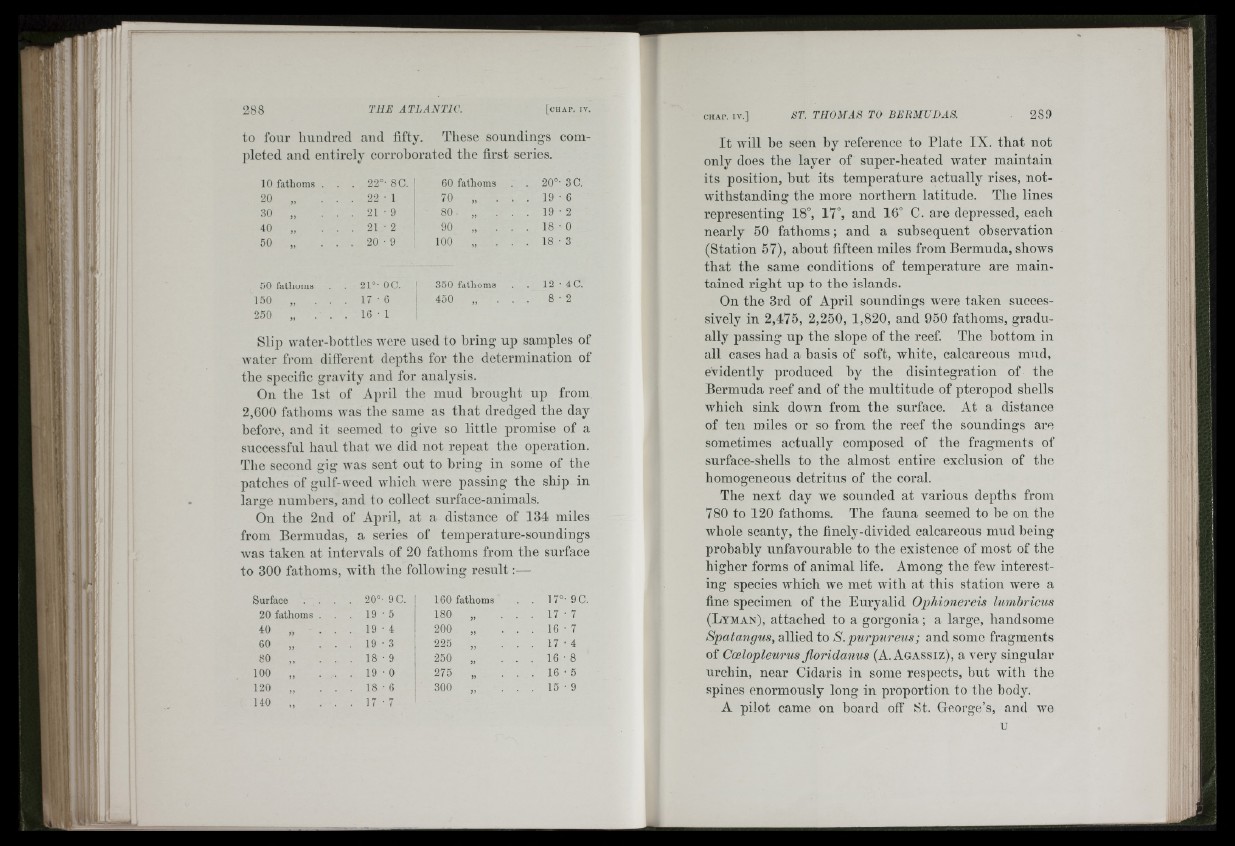
288 THE ATLANTIC.
to four liundred and fifty. These soundings completed
and entirely corroborated the first series.
10 fathoms .
20 „
30 „
40 „
50 „
.50 fathoms
1.50 „ .
250 „ .
22°- 8C.
22 • 1
21 • 9
21 • 2
20 • 9
21°- OC.
17 • C
16 • 1
60 fathoms
70 „ .
8 0 . „ .
90 „ .
100 .
350 fathoms
450 „ .
20°- 3 0.
19 • 6
19 • 2
18 • 0
18 ■ 3
12 • 4C.
8 • 2
Slip water-hottles tvere used to bring up samples of
water from diiferent depths for the determination of
the specific gravity and for analysis.
On the 1st of April the mud brought up from
2,600 fathoms Avas the same as that dredged the day
before, and it seemed to give so little promise of a
successful haul that Ave did not repeat the operation.
The second gig Avas sent out to bring in some of the
patches of gnlf-vveed Avhich Avere passing the ship in
large numhers, and to collect surface-animals.
On the 2nd of April, at a distance of 134 miles
from Bermudas, a series of temperature-soundings
Avas taken at intervals of 20 fathoms from the surface
to 300 fathoms, with the folloAving result:—
Surface . 20°- 9C. 160 fathoms . 17°-9C.
20 fathoms . . . 19 • 5 j 180 >> . 1 7 - 7
40 „ . . . 1 9 - 4 1 200 . 16 ■ 7
60 „ . . . 1 9 - 3 ' 225 >5 • • . 1 7 - 4
80 . . . 1 8 - 9 ■ 250 . 1 6 - 8
100 „ . . . 1 9 - 0 275 >> . 1 6 - 5
120 „ . . . 1 8 - 6 300 . 1 5 - 9
140 „ . . . 1 7 - 7
It Avill be seen by reference to Plate IX. that not
only does the layer of super-heated water maintain
its position, hut its temperature actually rises, notwithstanding
the more northern latitude. The lines
representing 18°, 17°, and 16° C. are depressed, each
nearly 50 fathoms; and a subsequent observation
(Station 57), about fifteen miles from Bermuda, shows
that the same conditions of temperature are maintained
right np to the islands.
On the 3rd of April soundings were taken successively
in 2,475, 2,250, 1,820, and 950 fathoms, gradually
passing up the slope of the reef. The hottom in
all cases had a basis of soft, white, calcareous mud,
evidently produced hy the disintegration of the
Bermuda reef and of the multitude of pteropod shells
which sink doAAm from the surface. At a distance
of ten miles or so from the reef the soundings are
sometimes actually composed of the fragments of
surface-shells to the almost entire exclusion of the
homogeneous detritus of the coral.
The next day we sounded at various depths from
780 to 120 fathoms. The fauna seemed to be on the
whole scanty, the finely-divided calcareous mud being
probably unfavourable to the existence of most of the
higher forms of animal life. Among the few interesting
species Avhich we met with at tliis station were a
fine specimen of the Euryalid Ophionereis Imnhricus
(Lyman), attached to a gorgonia; a large, handsome
Spatangus, allied to S.purpureus; and some fragments
of Ccelopleurus Jloridanus (A. Agassiz), a very singular
urchin, near Cidaris in some respects, but with the
spines enormously long in proportion to the body.
A pilot came on hoard off 8t. George’s, and AA'e
u
Ci
r;i
ii '6' ,A1 '!
If;:
i l l -
• - '1 - I
. i> ' 'i.
idS;;;